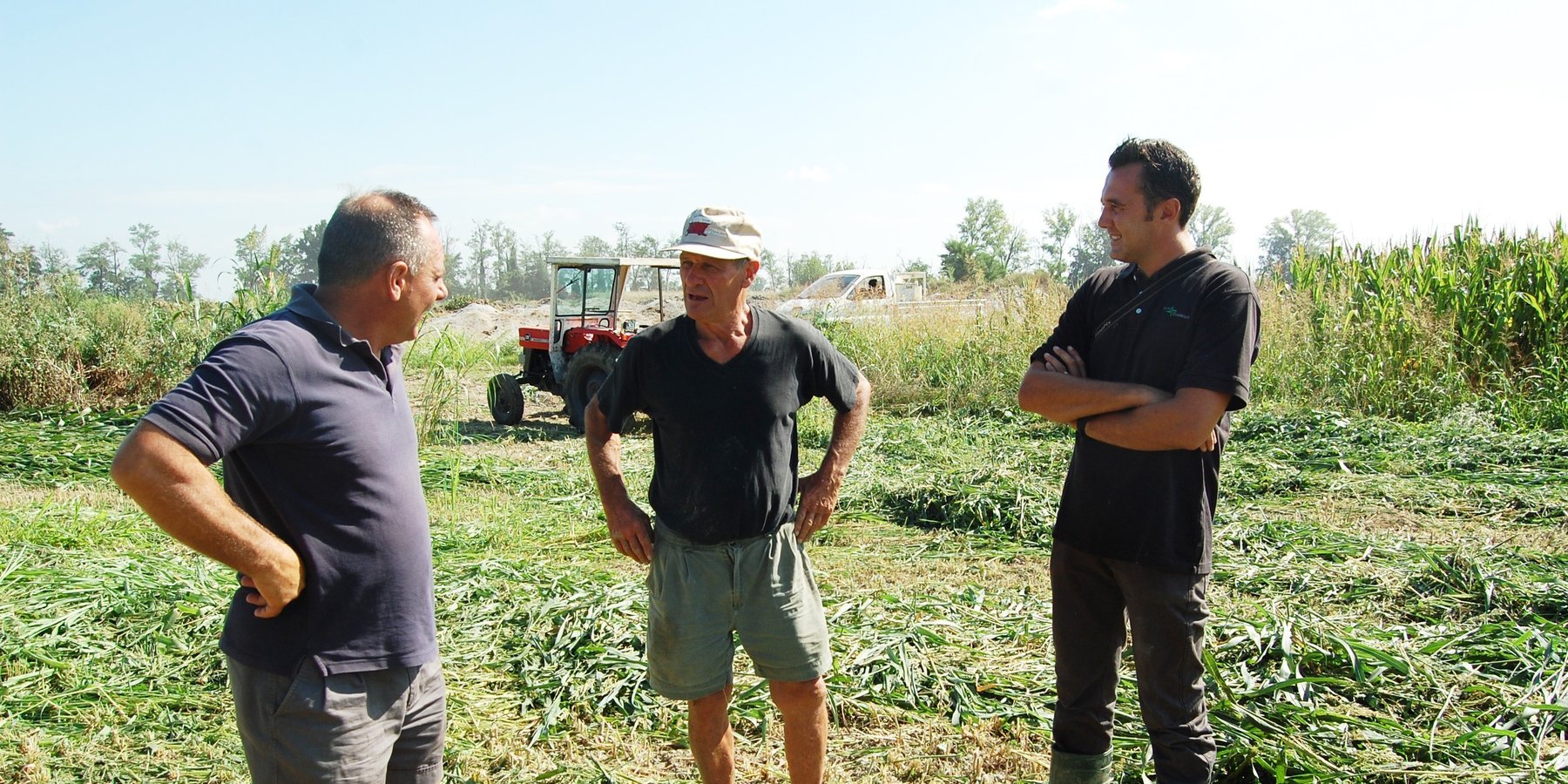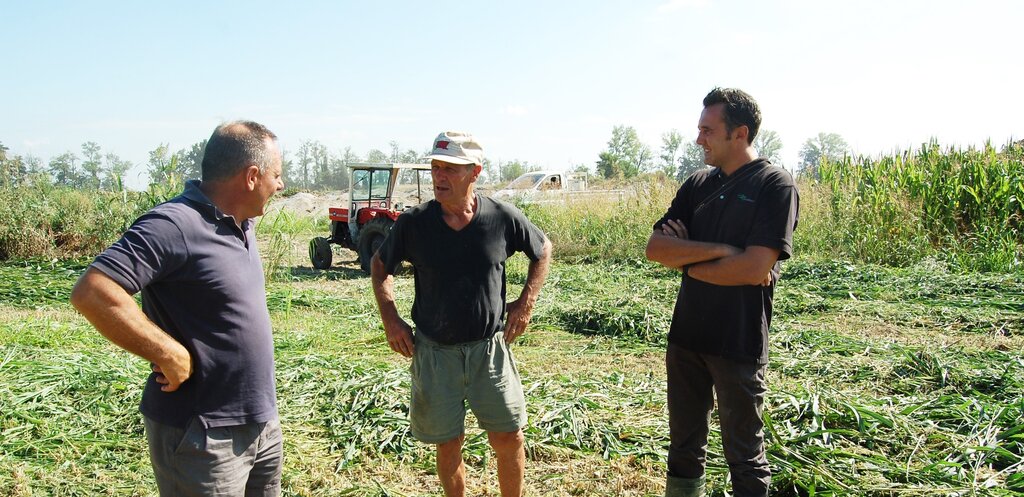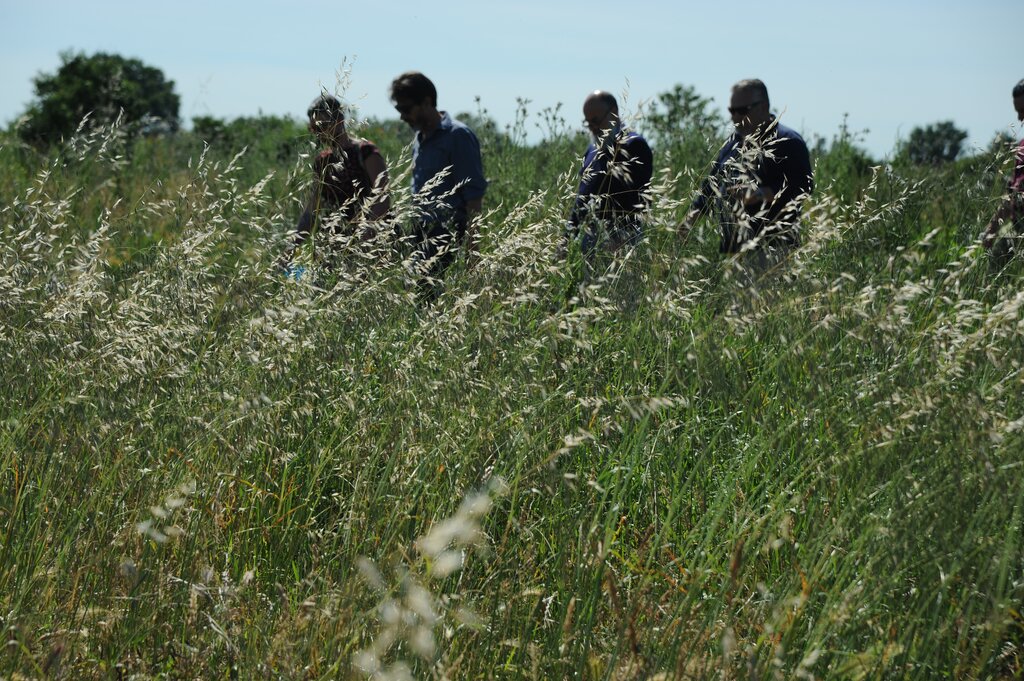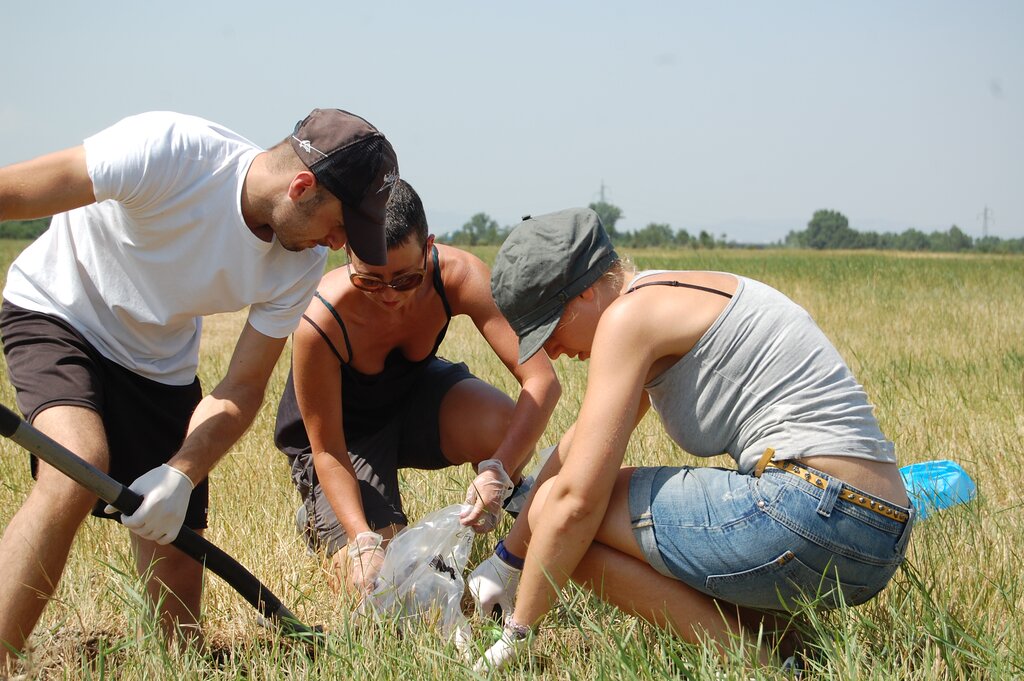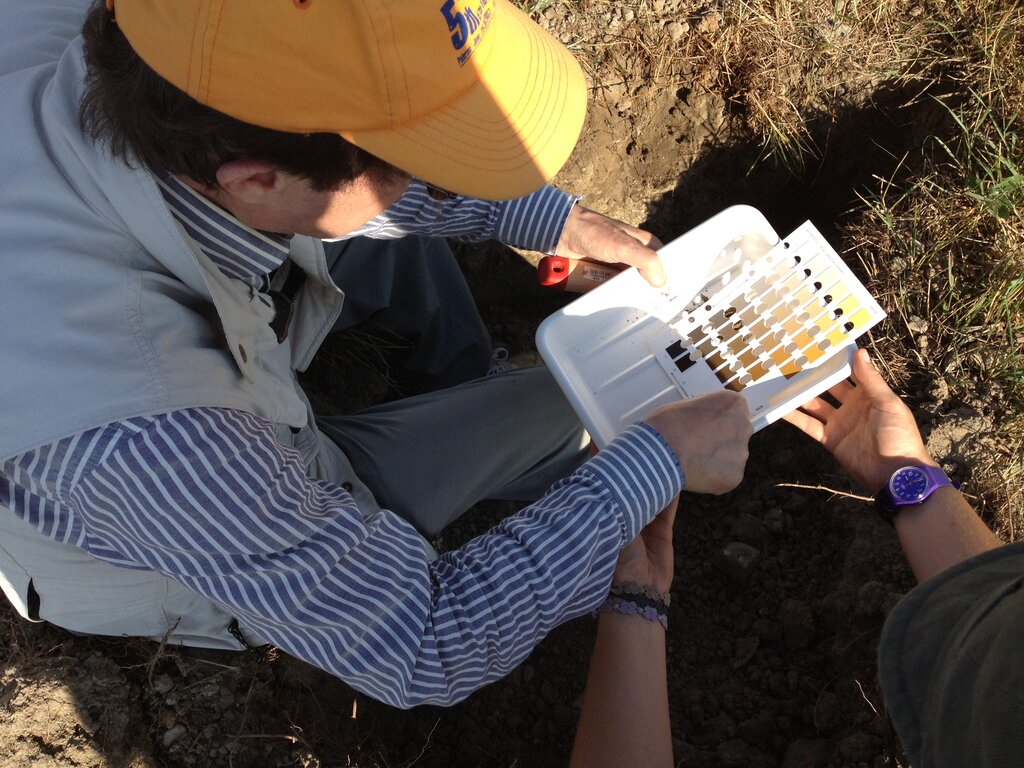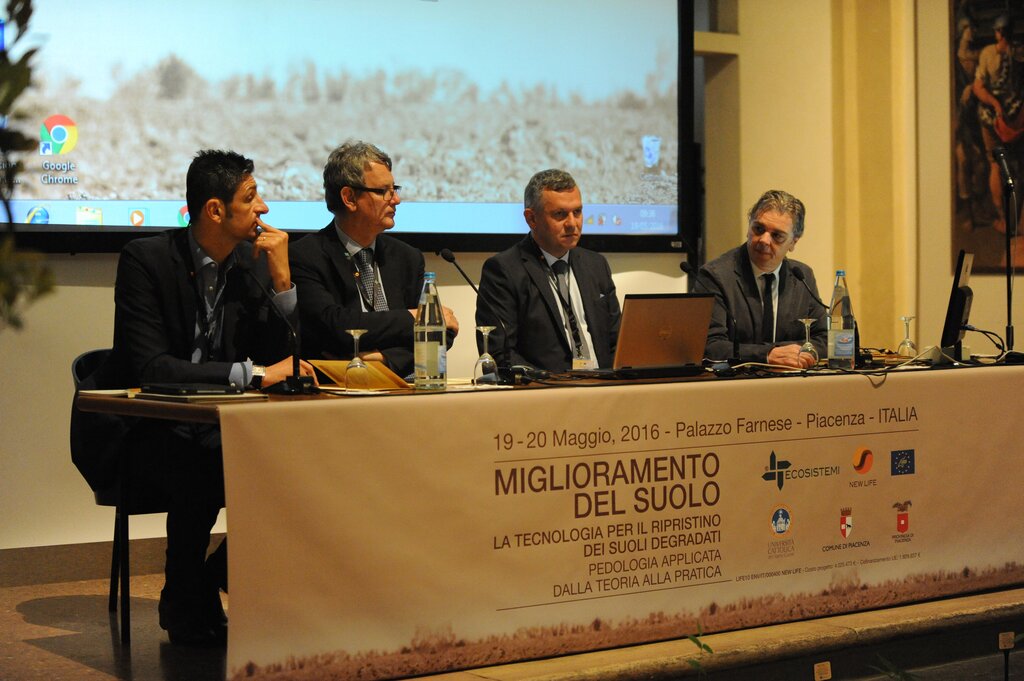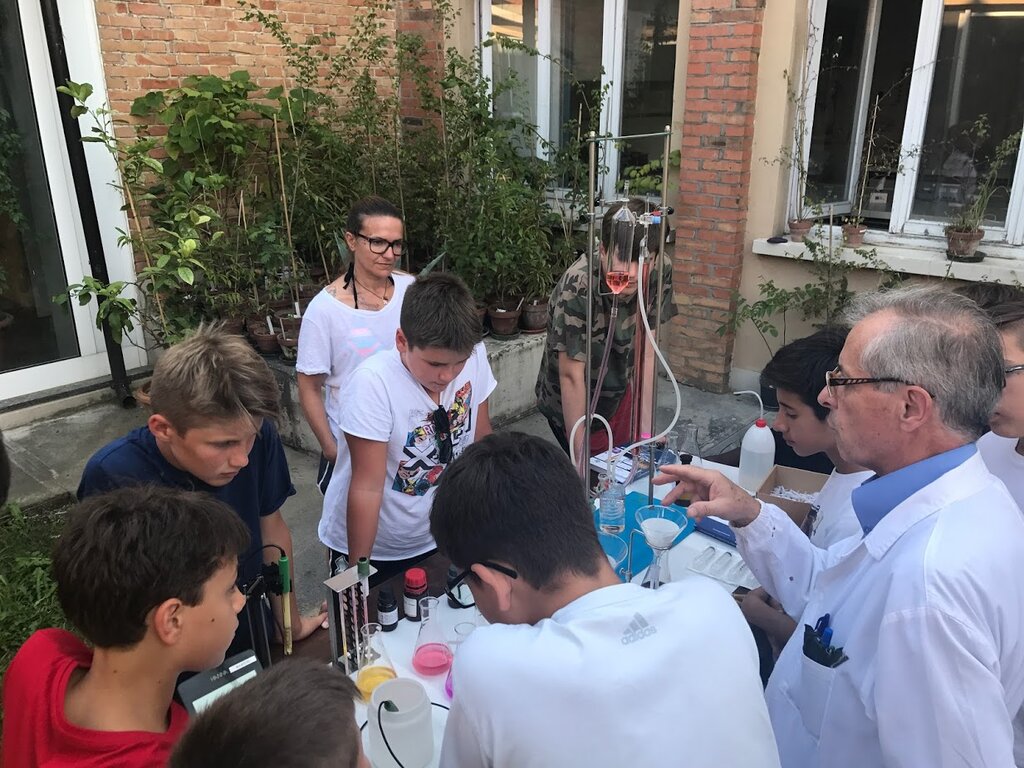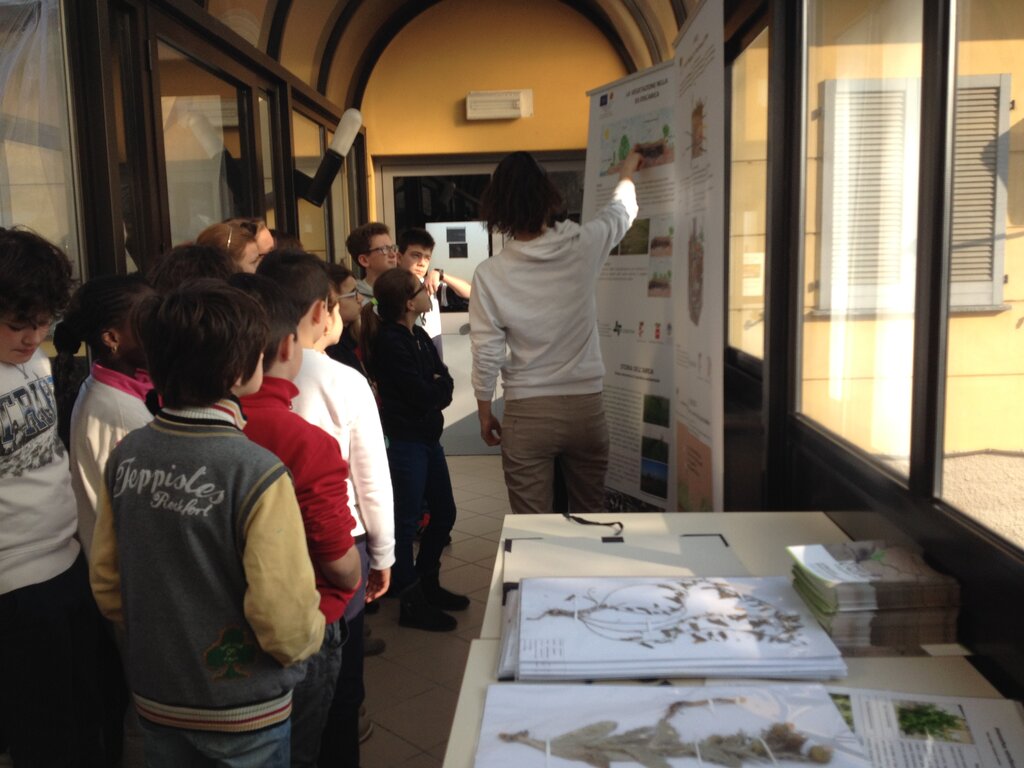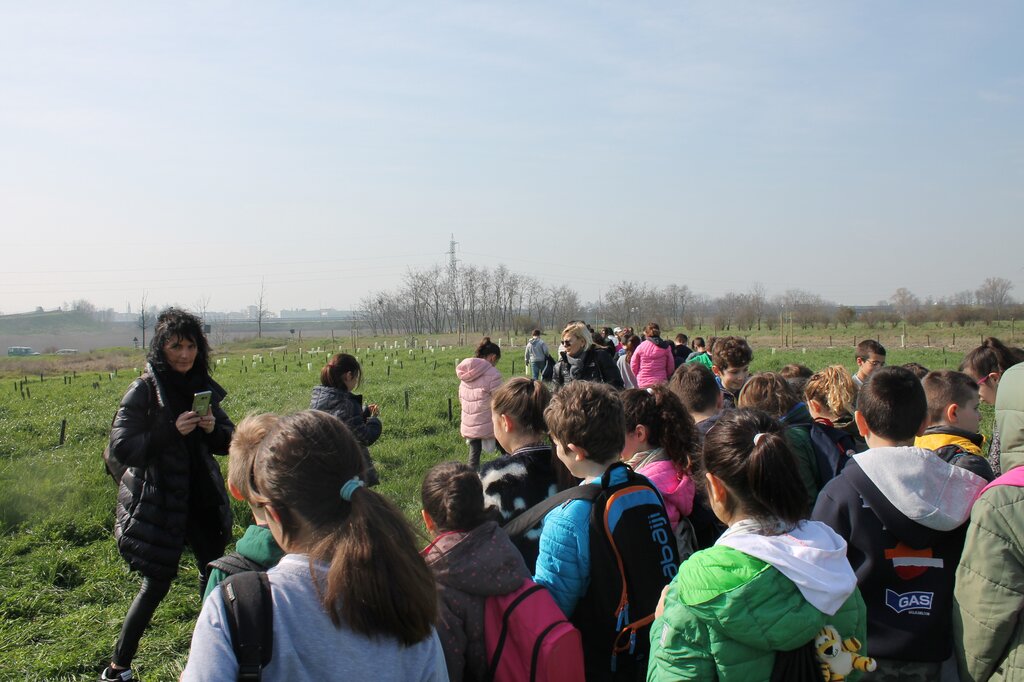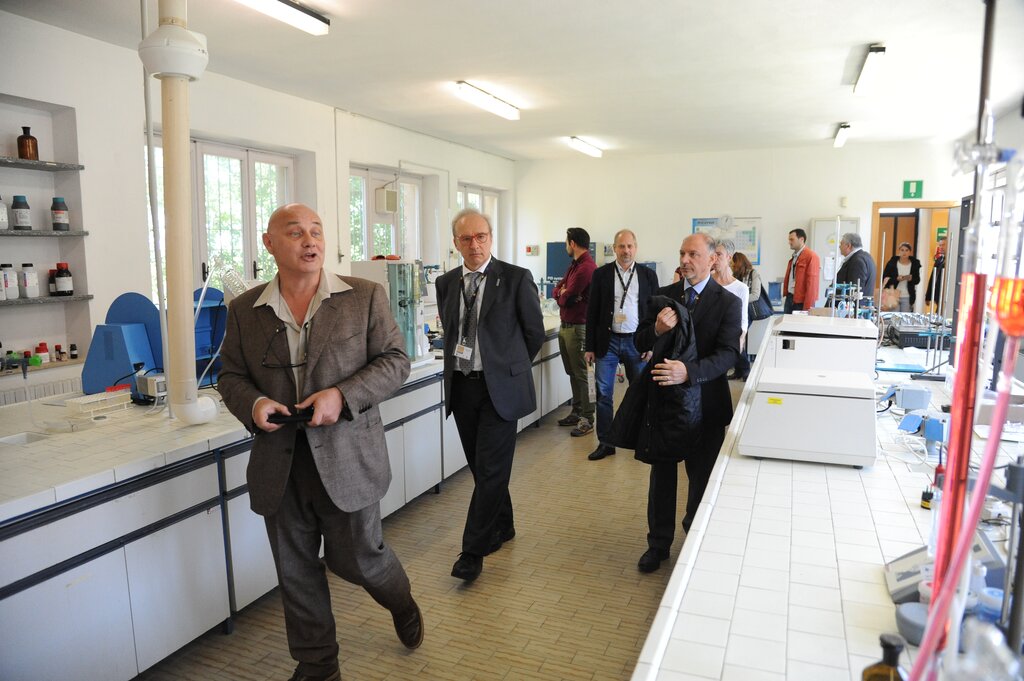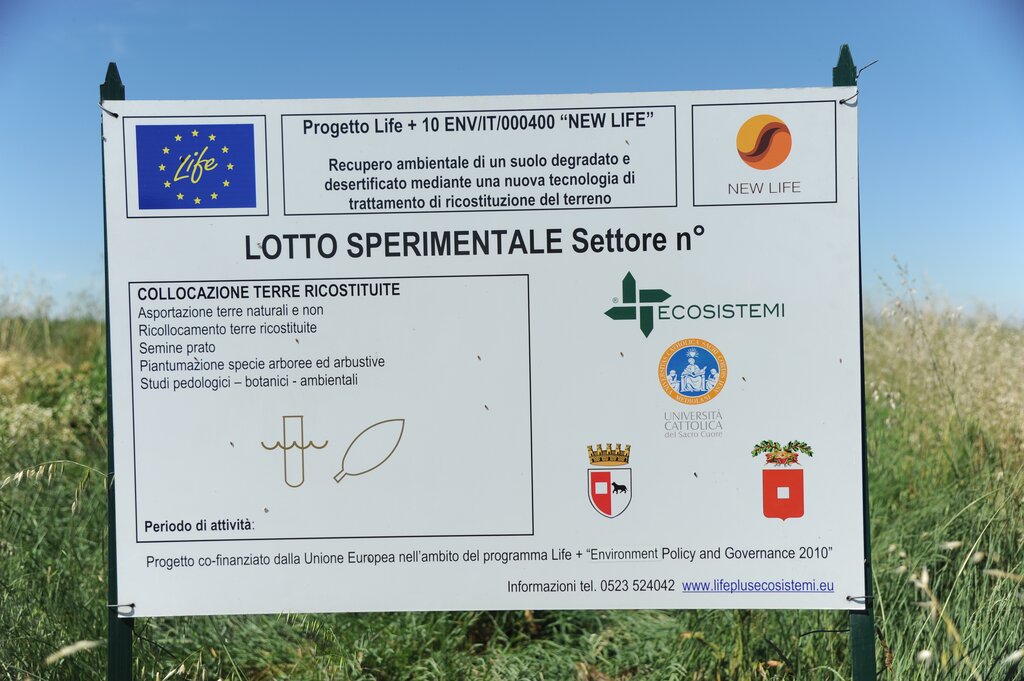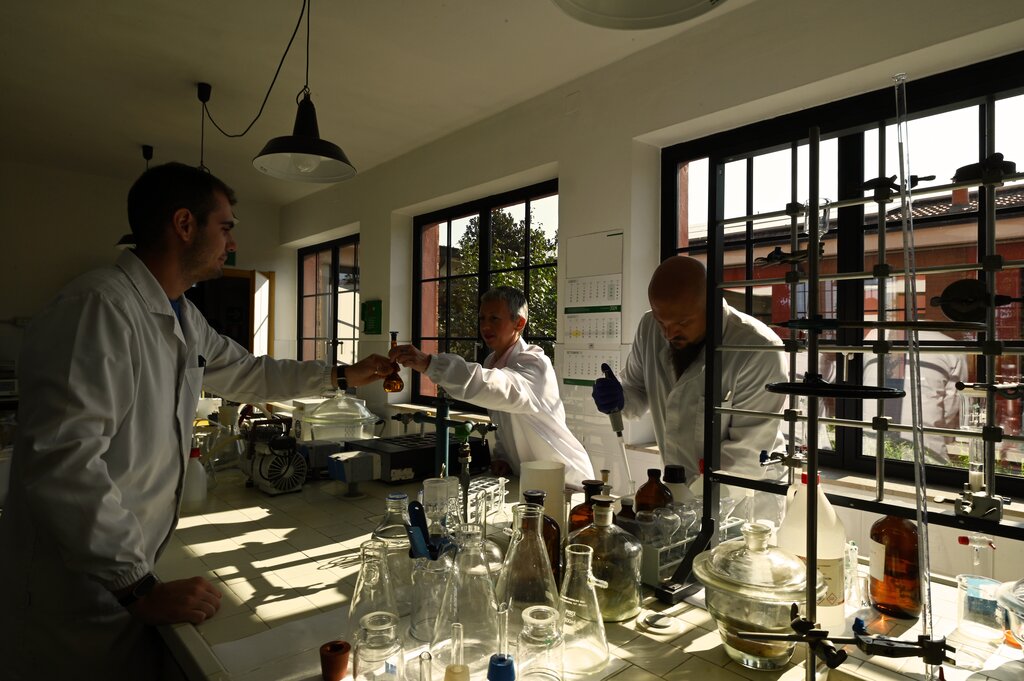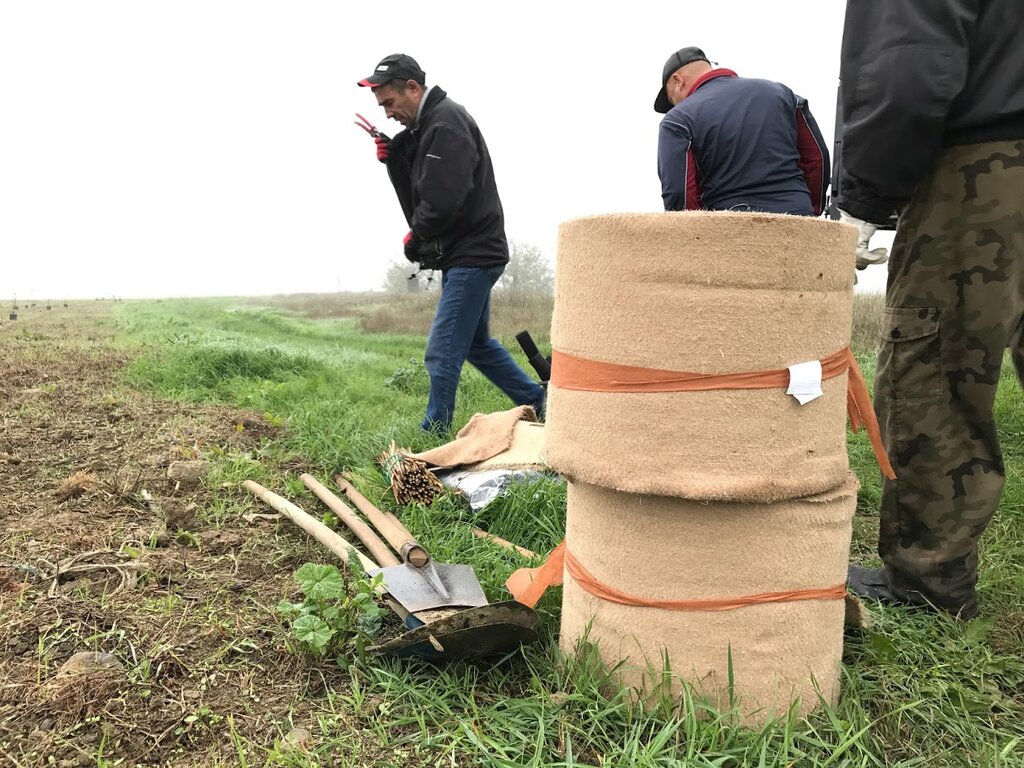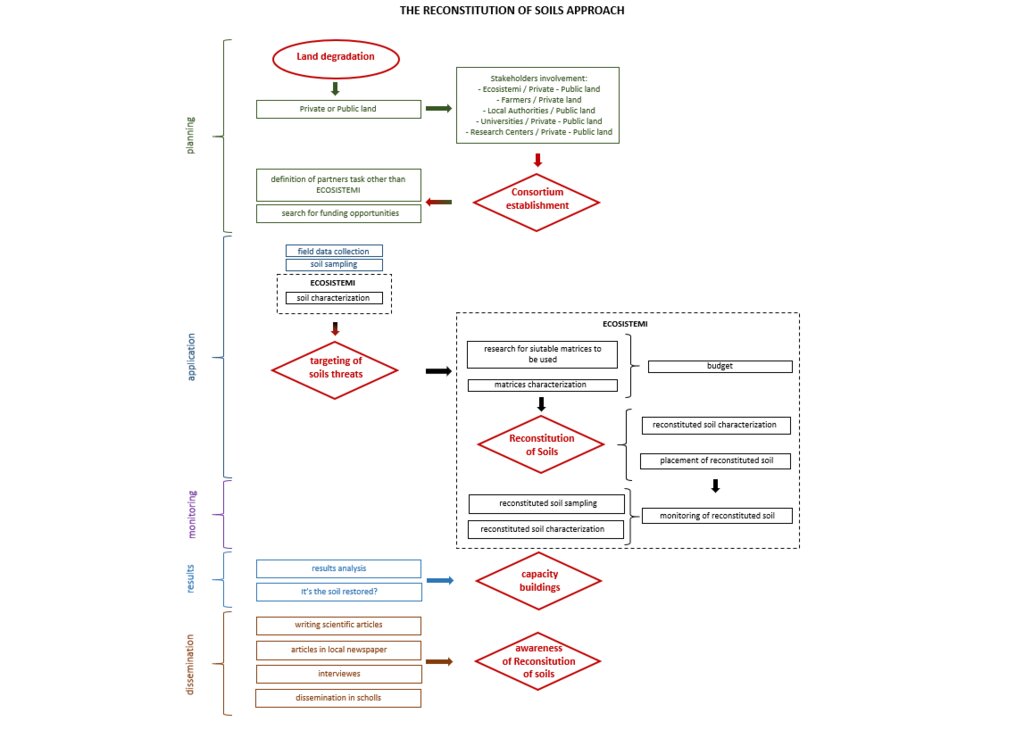Reconstitution of Soils Approach [ອີຕາລີ]
- ການສ້າງ:
- ປັບປູງ:
- ຜູ້ສັງລວມຂໍ້ມູນ: Chiara Cassinari
- ບັນນາທິການ: –
- ຜູ້ທົບທວນຄືນ: William Critchley, Rima Mekdaschi Studer
Ricostituzione
approaches_7355 - ອີຕາລີ
ເບິ່ງພາກສ່ວນ
ຂະຫຍາຍທັງໝົດ ຍຸບທັງໝົດ1. ຂໍ້ມູນທົ່ວໄປ
1.2 ລາຍລະອຽດ ການຕິດຕໍ່ ຂອງບຸກຄົນທີ່ຊັບພະຍາກອນ ແລະ ສະຖາບັນ ການມີສ່ວນຮ່ວມ ໃນການປະເມີນຜົນ ແລະ ເອກະສານ ຂອງວິທີທາງ
ບຸກຄົນສຳຄັນ (ຫຼາຍຄົນ)
ຜູ້ນໍາໃຊ້ທີ່ດິນ:
Manfredi Paolo
m.c.m. Ecosistemi
Loc. Faggiola snc, 29027 Podenzano
ອີຕາລີ
ຜູ້ຊ່ຽວຊານ ດ້ານການຄຸ້ມຄອງ ທີ່ດິນແບບຍືນຍົງ:
ຊື່ຂອງໂຄງການ ທີ່ອໍານວຍຄວາມສະດວກ ໃນການສ້າງເອກກະສານ ຫຼື ປະເມີນດ້ານແນວທາງ (ຖ້າກ່ຽວຂ້ອງ)
NEW LIFE Project (NEW LIFE)ຊື່ຂອງ ສະຖາບັນການຈັດຕັ້ງ ທີ່ອໍານວຍຄວາມສະດວກ ໃນການສ້າງເອກກະສານ ຫຼື ປະເມີນແນວທາງ (ຖ້າກ່ຽວຂ້ອງ)
m.c.m Ecosistemi (m.c.m Ecosistemi)1.3 ເງື່ອນໄຂ ຂອງການນໍາໃຊ້ເອກກະສານຂໍ້ມູນ ຂອງ WOCAT
ເມື່ອໃດທີ່ໄດ້ສັງລວມຂໍ້ມູນ (ຢູ່ພາກສະໜາມ)?
05/09/2023
ຜູ້ສັງລວມ ແລະ ບັນດາຜູ້ຕອບແບບສອບຖາມ ຍອມຮັບໃນເງື່ອນໄຂ ການນໍາໃຊ້ຂໍ້ມູນເອກະສານ ທີ່ສ້າງຂື້ນ ໂດຍຜ່ານ ອົງການ WOCAT:
ແມ່ນ
1.4 ເອກະສານອ້າງອີງ (ຫຼາຍ) ກັບແບບສອບຖາມ (ຫຼາຍ) ເຕັກໂນໂລຢີ ຂອງດ້ານການຄຸ້ມຄອງ ດິນແບບຍືນຍົງ

Reconstitution of Soils [ອີຕາລີ]
Reconstitution of soils is a pedotechnique based on the treatment of organic and non-organic pedomaterials to achieve benefits in areas with barren, degraded, desertified and/ or sealed soils.
- ຜູ້ສັງລວມຂໍ້ມູນ: Chiara Cassinari
2. ພັນລະນາ ແນວທາງການຄຸ້ມຄອງນໍາໃຊ້ດິນແບບຍືນຍົງ
2.1 ການອະທິບາຍ ໂດຍຫຍໍ້ ຂອງວິທີທາງ
Reconstitution of soils is a patented pedotechnology that brings benefits to degraded soils. Simultaneously, it raises awareness of the potential of restoring soil fertility through recycling. The approach starts with the identification of the soil issue, and the technology is then planned, implemented and promoted through a consortium.
2.2 ການອະທິບາຍ ລາຍລະອຽດ ຂອງວິທີທາງ
ການອະທິບາຍ ລາຍລະອຽດ ຂອງວິທີທາງ:
The approach to reconstitution of soils is guided and led by m.c.m. Ecosistemi in its role as a consortium leader, together with land users, soil experts and local authorities. Reconstitution of soils is a patented pedotechnology that brings benefits to degraded, barren and desertified soils. Simultaneously, it helps raise awareness of the potential of recycling in restoration of soil as part of a “circular economy”.
The technology of soil reconstitution arose about 20 years ago from a concept, later patented by Ecosistemi, to fight soil degradation through the guiding principle of recycling environmental suitable waste. From its conception until now, reconstitution has been improved and implemented through a consortium involving Ecosistemi, soil scientists, land users, farmers, and local authorities – while being supported by various national, European and international research projects.
To explain the approach in detail, one project more than any other has been central to demonstrating and promoting the technology: the EU project “New Life” (https://www.lifeplusecosistemi.eu/). The planning, application and monitoring phases under the New Life project are the same each time that reconstitution is the tool employed to restore an area.
To take one example under the New Life project, the intervention area was about 20 hectares in the Trebbia River Park (in the city of Piacenza, Italy). In the 1980s it was a landfill site for solid urban waste. When the landfill was closed, the waste was covered by a thin layer of soil on which rehabilitation efforts were carried out though planting trees and shrubs. However, these interventions, due to the poor quality of the soil used, failed, leaving the area in a state of continued degradation.
Some years later, after evaluating the state of the area, Ecosistemi proposed reconstitution as a potential tool for land restoration. As the land was a public area and large, it was necessary to find funding to support the restoration. Ecosistemi therefore contacted the University of Piacenza and local authorities to create a consortium, and after discussions Ecosistemi searched for funding opportunities. A proposal was drawn up for a restoration project which was then presented for funding under a EU programme and approved (https://www.lifeplusecosistemi.eu/). This then provided the go-ahead for successful restoration to form a recreational area.
Based this experience, the prototype for the approach to reconstitution of soils can be summarized as:
1) Identification of degraded land - through alerts from farmers and/ or local authorities and/ or universities;
2) Creation of a consortium;
3) Searching for funding opportunities (by the consortium), but if no funding is found, Ecosistemi prepares a profit and loss account using different scenarios to evaluate whether restoration is viable;
4) Assessing the soils threats to be solved - by the consortium;
5) Ecosistemi develops plans for implementation, based on core principles and practices of soil restoration;
6) Application of the restoration technology by Ecosistemi;
7) Monitoring of results by Ecosistemi and soil experts of the consortium;
8) Dissemination of the results through scientific articles, articles in local newspapers, interviews and in schools - by the consortium.
2.3 ຮູບພາບຂອງແນວທາງ
2.4 ວີດີໂອ ຂອງວິທີທາງ
ຄວາມຄິດເຫັນ, ຄໍາອະທິບາຍຫຍໍ້:
youtube video
https://www.youtube.com/watch?v=16kRp5AdhcY
Description of Reconstitution Pedotechnology
ວັນທີ:
15/01/2025
ຊື່ຂອງຜູ້ຖ່າຍວີດີໂອ:
Paolo Manfredi
ຄວາມຄິດເຫັນ, ຄໍາອະທິບາຍຫຍໍ້:
youtube video
https://www.youtube.com/watch?v=YRkxxzOHfTo
Reconstitution Approach on outcropping
ວັນທີ:
22/01/2025
ຊື່ຂອງຜູ້ຖ່າຍວີດີໂອ:
Paolo Manfredi
2.5 ປະເທດ / ເຂດ / ສະຖານທີ່ບ່ອນທີ່ແນວທາງໄດ້ຖືກນໍາໃຊ້
ປະເທດ:
ອີຕາລີ
ພາກພື້ນ / ລັດ / ແຂວງ:
Emilia Romagna, Piacenza; Piemonte, Vicolungo
Map
×2.6 ວັນທີເລີ່ມຕົ້ນ ແລະ ສິ້ນສຸດ ການຈັດຕັ້ງປະຕີບັດ ວິທີທາງ
ສະແດງປີຂອງການເລີ່ມຕົ້ນ:
2011
ຄວາມຄິດເຫັນ:
The Reconstitution of Soils Approach is constantly evolving
2.7 ປະເພດຂອງແນວທາງ
- research, growth, innovation
2.8 ເປົ້າໝາຍ / ຈຸດປະສົງຫຼັກ ຂອງການຈັດຕັ້ງປະຕິບັດ ວິທີທາງ
The reconstitution of soils approach, whose guiding principle is the "circular economy", copes with land degradation and desertification. The approach's aim is to support the implementation of the "reconstitution of soils" technology , creating a consortium of soil experts, local authorities and people with the aim of restoring degraded land, sealed soils, soils with low chemical and/ or physical fertility.
2.9 ເງື່ອນໄຂອໍານວຍ ຫຼື ຂັດຂວາງການປະຕິບັດຂອງເຕັກໂນໂລຢີ / ເຕັກໂນໂລຢີການນໍາໃຊ້ຕາມແນວທາງ
ສັງຄົມ / ວັດທະນະທໍາ / ມາດຕະຖານ ແລະ ຄຸນຄ່າທາງສາສະໜາ
- ອໍານວຍ
Because of soil health concerns, there is awareness of soil threats, increase of yield, increase of tillable area, wealth, and environmental health and these are increased through restoration of land by reconstitution.
ມີຄວາມສາມາດ / ເຂັ້າເຖິງຊັບພະຍາກອນດ້ານການເງິນ ແລະ ການບໍລິການ
- ອໍານວຍ
The availability of funding for regional, national or international projects can help implement the approach because of all the implementations (increasing circular economy testing with new suitable waste and studying ad-hoc soil restoration according to the soil issue to be solved) needs subsides. If no funding is found a profit and loss account is made to evaluate if the restoration can be made exploring different scenarios.
ການຮ່ວມມື / ການປະສານງານຂອງຜູ້ກ່ຽວຂ້ອງ
- ອໍານວຍ
Local farmers and authorities, whenever the skills of Ecosistemi and of reconstitution of soils is needed, are open to collaboration and becoming part of a consortium.
ນະໂຍບາຍ
- ອໍານວຍ
Policies concerning strategies on soil desertification enable the approach.
ການປົກຄອງທີ່ດິນ (ການຕັດສິນໃຈ, ການປະຕິບັດ ແລະ ຂໍ້ບັງຄັບ)
- ອໍານວຍ
Land governance enables people to become aware of soil threats and to join the approach as one way to solve them.
ຄວາມຮູ້ກ່ຽວກັບການຄຸ້ມຄອງ ທີ່ດິນແບບຍືນຍົງ, ການເຂົ້າເຖິງການສະໜັບສະໜູນ ທາງດ້ານວິຊາການ
- ອໍານວຍ
Knowledge about SLM and the access to technical support is useful to take examples for implementing the approach.
3. ການມີສ່ວນຮ່ວມ ແລະ ບົດບາດຂອງພາກສ່ວນທີ່ກ່ຽວຂ້ອງທີ່ໄດ້ມີສ່ວນຮ່ວມ
3.1 ຜູ້ມີສ່ວນຮ່ວມ ໃນວິທີທາງ ແລະ ພາລະບົດບາດ ຂອງເຂົາເຈົ້າ
- ຜູ້ຊ່ຽວຊານ ການນຄຸ້ມຄອງ ທີ່ດິນແບບຍືນຍົງ / ທີ່ປຶກສາດ້ານກະສິກໍາ
m.c.m. Ecosistemi company
Lead role in the approach because of Reconstitution of Soils is patented by Ecosistemi
- ນັກຄົ້ນຄວ້າ
Soil experts, m.c.m. Ecosistemi research laboratory
Studies about soils, monitoring reconstituted soils
- ພາກເອກະຊົນ
Ecosistemi company and the sectors producing suitable waste to be used
Ecosistemi tests suitable waste to be used in Reconstitution of Soils
- ອໍານາດ ການປົກຄອງທ້ອງຖິ່ນ
Municipality
Local Government is the key to create a connection with local people, to find areas to be restored and for dissemination of the results obtained through SLM Technology
- ພະນັກງານຂັ້ນສູນກາງ (ຜູ້ວາງແຜນ, ຜູ້ສ້າງນະໂຍບາຍ)
Planners and decision-makers
Their roles are to plan, support and encourage actions for soil restoration
ຖ້າຫາກມີຫຼາຍພາກສ່ວນທີ່ເຂົ້າຮ່ວມ ໃຫ້ລະບຸ ອົງການທີ່ເປັນຫຼັກ ໃນການຈັດຕັ້ງປະຕິບັດ:
m.c.m. Ecosistemi
3.2 ການມີສ່ວນຮ່ວມຂອງຜູ້ນໍາໃຊ້ທີ່ດິນໃນທ້ອງຖິ່ນ / ຊຸມຊົນທ້ອງຖິ່ນໃນໄລຍະທີ່ແຕກຕ່າງກັນຂອງແນວທາງ
| ການລວບລວມ ເອົາຜູ້ນໍາໃຊ້ດິນ ໃນທ້ອງຖິ່ນ / ຊຸມຊົນທ້ອງຖິ່ນ | ໃຫ້ລະບຸ ຜູ້ໃດທີ່ມີສ່ວນຮ່ວມ ໃນແຕ່ລະກິດຈະກໍາ? | |
|---|---|---|
| ການເລີ່ມຕົ້ນ / ແຮງຈູງໃຈ | ການຮ່ວມມື | Iniziation of the approach started from the identification of the threat to be solved and so local users are key actors |
| ການວາງແຜນ | ການຮ່ວມມື | Planning is made by all the stakeholders of the approach leading by Ecosistemi |
| ການປະຕິບັດ | ບໍ່ມີ | Implementation is carried out only by m.c.m. Ecosistemi |
| ຕິດຕາມກວດກາ / ການປະເມີນຜົນ | ການຮ່ວມມື | They take part in monitoring the results about for example their perception of a restored land after the application of the approach |
3.3 ແຜນວາດ (ຖ້າມີ)
3.4 ການຕັດສິນໃຈກ່ຽວກັບການຄັດເລືອກເຕັກໂນໂລຢີຂອງການຄຸ້ມຄອງທີ່ດິນແບບຍືນຍົງ / ເຕັກໂນໂລຢີ
ລະບຸ ຄົນທີ່ຕັດສິນໃຈ ກ່ຽວກັບການຄັດເລືອກຂອງ ເຕັກໂນໂລຢີ / ເຕັກໂນໂລຢີ ຈະໄດ້ຮັບການປະຕິບັດ:
- ພາກສ່ວນກ່ຽວຂ້ອງທັງໝົດ, ເປັນສ່ວນໜຶ່ງ ຂອງວິທີທາງແບບມີສ່ວນຮ່ວມ
ອະທິບາຍ:
Ecosistemi, as it is the leader of the approach, decides about the implementation of Reconstitution of Soils Approach because only they have the whole knowledge about Reconstitution of Soils and soil threats
Specify on what basis decisions were made:
- ປະເມີນເອກກະສານ ຄວາມຮູ້ກ່ຽວກັບ ການຄຸ້ມຄອງ ທີ່ດິນແບບຍືນຍົງ (ຫຼັກຖານທີ່ຊ່ວຍໃນການຕັດສິນໃຈ)
- ຜົນທີ່ໄດ້ຮັບ ຈາກການຄົ້ນຄວ້າ
- ປະສົບການສ່ວນບຸກຄົນ ແລະ ຄວາມຄິດເຫັນ (ທີ່ບໍ່ເປັນເອກກະສານ)
4. ການສະໜັບສະໜູນທາງດ້ານວິຊາການ, ການສ້າງຄວາມສາມາດ, ແລະ ການຈັດການຄວາມຮູ້.
4.1 ການສ້າງຄວາມສາມາດ / ການຝຶກອົບຮົມ
ຜູ້ນໍາໃຊ້ທີ່ດິນ ຫຼື ພາກສ່ວນກ່ຽວຂ້ອງອື່ນໆ ໄດ້ຮັບການຝຶກອົບຮົມບໍ່?
ແມ່ນ
ໃຫ້ລະບຸ ຜູ້ໃດທີ່ໄດ້ຮັບການຝຶກອົບຮົມ:
- ພະນັກງານພາກສະໜາມ / ທີ່ປຶກສາ
ຖ້າເປັນໄປໄດ້, ໃຫ້ລະບຸເພດ, ອາຍຸ, ສະຖານະພາບ, ຊົນເຜົ່າ, ແລະ ອື່ນໆ:
Gender is inclusive; everyone can be trained
ຮູບແບບຂອງການຝຶກອົບຮົມ:
- ການເຮັດຕົວຈິງ
- ເນື້ອທີ່ສວນທົດລອງ
- ກອງປະຊຸມ
ໃນຫົວຂໍ້:
Natural soil management, organic matter conservation, reconstituted soil management, agricultural management
4.2 ການບໍລິການໃຫ້ຄໍາປຶກສາ
ເຮັດຜູ້ໃຊ້ທີ່ດິນມີການເຂົ້າເຖິງການບໍລິການໃຫ້ຄໍາປຶກສາ?
ແມ່ນ
ລະບຸວ່າການສະໜອງ ການບໍລິການ ໃຫ້ຄໍາປຶກສາ:
- ໃນພື້ນທີ່ຂອງຜູ້ນໍາໃຊ້ດິນ
- ສູນຄົ້ນຄວ້າ
ອະທິບາຍ / ຄວາມຄິດເຫັນ:
Training on natural and reconstituted soils management, on soil degradation processes, on the production process used by company providing waste to be tested in the approach
4.3 ສະຖາບັນການສ້າງຄວາມເຂັ້ມແຂງ (ການພັດທະນາອົງການຈັດຕັ້ງ)
ສະຖາບັນ ໄດ້ຮັບການສ້າງຕັ້ງຂື້ນ ຫຼື ໄດ້ຮັບການສ້າງຄວາມເຂັ້ມແຂງ ໂດຍການຈັດຕັ້ງປະຕິບັດ ວິທີທາງບໍ່?
- ມີ, ພໍສົມຄວນ
ລະບຸ ທາງສະຖາບັນ ໄດ້ສ້າງຄວາມເຂັ້ມແຂງ ໃນລະດັບໃດ (ຫຼາຍ):
- ທ້ອງຖິ່ນ
- ລະດັບພາກພື້ນ
ອະທິບາຍ ສະຖາບັນການຈັດຕັ້ງ, ພາລະບົດບາດ ແລະ ໜ້າທີ່ຮັບຜິດຊອບ, ສະມາຊິກ ແລະ ອື່ນໆ.
Local and regional institutions such as municipality and trade associations, have the roles of the dissemination of the results through people and of financial support
ລະບຸ ປະເພດ ຂອງສະໜັບສະໜູນ:
- ທາງດ້ານການເງິນ
- dissemination
ໃຫ້ລາຍລະອຽດເພີ່ມເຕີມ:
Search for funding opportunities (regional projects): dissemination of the results through articles in local newspapers and/ or interviews
4.4 ຕິດຕາມກວດກາ ແລະ ປະເມີນຜົນ
ການຈັດຕັ້ງປະຕິບັດ ວິທີທາງ ໄດ້ມີການປະເມີນຜົນ ແລະ ຕິດຕາມບໍ?
ແມ່ນ
ຄວາມຄິດເຫັນ:
Soil monitoring and evaluation are the only way to know if the technology is able to solve soil problem to cope with. After that the obtained results can be disseminated and so to eventually find a new area to start a new implementation
ຖ້າແມ່ນ, ເອກກະສານສະບັບນີ້ ແມ່ນໄດ້ນໍາໃຊ້ເຂົ້າໃນການຕິດຕາມ ແລະ ປະເມີນຜົນບໍ່?
ແມ່ນ
ຄວາມຄິດເຫັນ:
Every implementation is the base for a new project and to increase the development of the approach
4.5 ການຄົ້ນຄວ້າ
ນີ້້ແມ່ນສ່ວນໜຶ່ງ ການຄົ້ນຄວ້າ ຂອງວິທີທາງບໍ່?
ແມ່ນ
ລະບຸ ຫົວຂໍ້:
- ເສດຖະສາດ / ການຕະຫຼາດ
- ລະບົບນິເວດ
- ເຕັກໂນໂລຢີ
ໃຫ້ຂໍ້ມູນ ເພີ່ມເຕີມ ແລະ ກໍານົດ ຜູ້ໃດເຮັດການຄົ້ນຄວ້າ:
All the research is be done by m.c.m. Ecosistemi sometimes together with local institutions and/ or soil experts; the topics of the research are: chemico-physical and microbiological soils parameters, soils uses, circular economy, soil management and yield, laboratory soil analysis, suitable waste, vegetation indices, and soil fertility.
5. ການສະໜັບສະໜູນທາງດ້ານການເງິນ ແລະ ອຸປະກອນຈາກພາຍນອກ
5.1 ງົບປະມານປະຈໍາປີ ສໍາລັບວິທີທາງ ຂອງການຄຸ້ມຄອງ ທີ່ດິນແບບຍືນຍົງ
ຖ້າຫາກບໍ່ຮູ້ຈັດງົບປະມານທີ່ແນ່ນອນ ແມ່ນໃຫ້ປະມານເອົາ:
- 100,000-1,000,000
ຄໍາເຫັນ (ຕົວຢ່າງ: ແຫຼ່ງຂໍ້ມູນຫຼັກ ຂອງການສະໜອງທຶນ / ຜູ້ໃຫ້ທຶນທີ່ສໍາຄັນ):
this annual budget originates from New Life project (https://www.lifeplusecosistemi.eu/) and it covers the restoration of a 10 ha land, involving 8-10 people, and all the other associated aspects of the approach.
5.2 ການສະໜັບສະໜູນ ທາງດ້ານການເງິນ / ອຸປະກອນ ສະໜອງໃຫ້ແກ່ຜູ້ນໍາທີ່ດິນ
ຜູ້ນໍາໃຊ້ດິນ ໄດ້ຮັບການສະໜັບສະໜູນ ທາງດ້ານ ການເງິນ / ອຸປະກອນ ໃນການຈັດຕັ້ງປະຕິບັດ ເຕັກໂນໂລຢີບໍ?
ແມ່ນ
ຖ້າແມ່ນ, ໃຫ້ລະບຸປະເພດ (ຫຼາຍ) ຂອງການສະໜັບສະໜູນ, ເງື່ອນໄຂ ແລະ ຜູູ້ສະໜອງ (ຫຼາຍ):
Subsidies from funding programs based on a research project
5.3 ເງິນສົມທົບສໍາລັບການນໍາໃຊ້ສະເພາະປັດໃຈຂາເຂົ້າໃນການຜະລີດກະສິກໍາ (ລວມທັງແຮງງານ)
- ແຮງງານ
| ທີ່ຂອບເຂດ | ລະບຸ ການອຸດໜູນ |
|---|---|
| ງົບປະມານບາງສ່ວນ | Funding programs |
- ອຸປະກອນ
| ໃຫ້ລະບຸໄດ້ຮັບການສະໜັບສະໜູນປັດໃຈຂາເຂົ້າຫຍັງແດ່ | ທີ່ຂອບເຂດ | ລະບຸ ການອຸດໜູນ |
|---|---|---|
| ເຄື່ອງມື | ງົບປະມານບາງສ່ວນ | Founding programs |
| pilot laboratory reconstituted plant | ງົບປະມານບາງສ່ວນ | Subsides by funding programs are useful if a project needs a characteristic type of reconstitution or if new waste are to be tested and the amount of them are little, it could be necessary to produce a pilot laboratory reconstitution plant |
ຖ້າແຮງງານ ຂອງຜູ້ນໍາໃຊ້ດິນ ໄດ້ຮັບການສະໜັບສະໜູນ ປັດໃຈຂາເຂົ້າ, ແມ່ນບໍ່:
- ຈ່າຍເປັນເງິນສົດ
5.4 ສິນເຊື່ອ
ໄດ້ປ່ອຍສິນເຊື່ອ ສະໜອງໃຫ້ພາຍໃຕ້ ວິທີການສໍາລັບກິດຈະກໍາ ການຄຸ້ມຄອງ ທີ່ດິນແບບຍືນນຍົງບໍ່?
ບໍ່ແມ່ນ
5.5 ສິ່ງຈູງໃຈ ຫຼື ເຄື່ອງມືອື່ນໆ
ການສົ່ງເສີມ ຈັດຕັ້ງປະຕິບັດ ເຕັກໂນໂລຢີ ໃນການຄຸ້ມຄອງ ດິນແບບຍືນຍົງ ໄດ້ສະໜອງສິ່ງກະຕຸກຊຸກຍູ້ບໍ່?
ບໍ່ແມ່ນ
6. ວິເຄາະຜົນກະທົບ ແລະ ສັງລວມບັນຫາ
6.1 ຜົນກະທົບຂອງແນວທາງ
ວິທີທາງ ຊ່ວຍຊຸກຍູ້ ຜູ້ນຳໃຊ້ທີ່ດິນທ້ອງຖີ່ນ, ໃນການປັບປຸງ ການມີສ່ວນຮ່ວມ ຂອງຜູ້ທີ່ກ່ຽວຂ້ອງ ບໍ່?
- ບໍ່
- ມີ, ໜ້ອຍໜຶ່ງ
- ມີ, ພໍສົມຄວນ
- ມີ, ຫຼາຍ
The creation of consortium of stakeholders is very useful for brainstorming about different ideas and to join skills to solve soils threats
ການນໍາໃຊ້ ວິທີທາງ ດັ່ງກ່າວນີ້ ສາມາດເປັນຫຼັກຖານ ທີ່ສະໜັບສະໜູນ ໃຫ້ການຕັດສິນໃຈໄດ້ບໍ່?
- ບໍ່
- ມີ, ໜ້ອຍໜຶ່ງ
- ມີ, ພໍສົມຄວນ
- ມີ, ຫຼາຍ
The results obtain using the approach are the basis for future implementation of the technology
ການຈັດຕັ້ງປະຕິບັດ ວິທີທາງ ສາມາດຊ່ວຍຜູ້ນໍາໃຊ້ທີ່ດິນ ໃນການຈັດຕັ້ງປະຕິບັດ ແລະ ບໍາລຸງຮັກສາ ເຕັກໂນໂລຢີ ການຄຸ້ມຄອງ ທີ່ດິນແບບຍືນຍົງໄດ້ບໍ?
- ບໍ່
- ມີ, ໜ້ອຍໜຶ່ງ
- ມີ, ພໍສົມຄວນ
- ມີ, ຫຼາຍ
The approach is the core concept underpinning implementation of the technology
ການນໍາໃຊ້ ວິທີທາງ ສາມາດປັບປຸງ ການປະສານງານ ແລະ ຄ່າໃຊ້ຈ່າຍ ການຈັດຕັ້ງປະຕິບັດ ທີ່ມີປະສິດທິພາບ ຂອງການຄຸ້ມຄອງ ທີ່ດິນແບບຍືດຍົງໄດ້ບໍ່?
- ບໍ່
- ມີ, ໜ້ອຍໜຶ່ງ
- ມີ, ພໍສົມຄວນ
- ມີ, ຫຼາຍ
Thanks to the approach and the establishment of a consortium, a project for funding programs can be presented
ການນໍາໃຊ້ ວິທີທາງ ສາມາດລະດົມ ຫຼື ປັບປຸງ ການເຂົ້າເຖິງຊັບພະຍາກອນ ການເງິນ ສໍາລັບການຈັດຕັ້ງປະຕິບັດ ການຄຸ້ມຄອງ ທີ່ດິນແບບຍືດຍົງໄດ້ບໍ່?
- ບໍ່
- ມີ, ໜ້ອຍໜຶ່ງ
- ມີ, ພໍສົມຄວນ
- ມີ, ຫຼາຍ
The approach can be tested in EU and Horizon projects
ການນໍາໃຊ້ ວິທີທາງ ສາມາດປັບປຸງຄວາມຮູ້ ແລະ ຄວາມສາມາດຂອງຜູ້ນໍາໃຊ້ທີ່ດິນ ໃນການປະຕິບັດ ການຄຸ້ມຄອງ ທີ່ດິນແບບຍືດຍົງໄດ້ບໍ່?
- ບໍ່
- ມີ, ໜ້ອຍໜຶ່ງ
- ມີ, ພໍສົມຄວນ
- ມີ, ຫຼາຍ
The consortium is useful to connect skills and so to implement the technology
ການນໍາໃຊ້ ວິທີທາງ ສາມາດປັບປຸງຄວາມຮູ້ ແລະ ຄວາມສາມາດ ຂອງພາກສ່ວນທີ່ກ່ຽວຂ້ອງໄດ້ບໍ່?
- ບໍ່
- ມີ, ໜ້ອຍໜຶ່ງ
- ມີ, ພໍສົມຄວນ
- ມີ, ຫຼາຍ
Joining skills is always a way to improve knowledge
ການນໍາໃຊ້ ວິທີທາງ ສາມາດສ້າງຄວາມເຂັ້ມແຂງ ໃຫ້ສະຖາບັນການຈັດຕັ້ງ, ການຮ່ວມມື ລະຫວ່າງພາກສ່ວນທີ່ກ່ຽວຂ້ອງບໍ່?
- ບໍ່
- ມີ, ໜ້ອຍໜຶ່ງ
- ມີ, ພໍສົມຄວນ
- ມີ, ຫຼາຍ
Working together for the same aim strengthen collaboration
ການຈັດຕັ້ງປະຕິບັດ ວິທີທາງ ສາມາດຊຸກຍູ້ ຜູ້ນໍາໃຊ້ທີ່ດິນທີ່ເປັນຊາວໜຸ່ມ / ຄົນລຸ້ນໃໝ່ ໃນການຄຸ້ມຄອງ ທີ່ດິນແບບຍືນຍົງໄດ້ບໍ?
- ບໍ່
- ມີ, ໜ້ອຍໜຶ່ງ
- ມີ, ພໍສົມຄວນ
- ມີ, ຫຼາຍ
The dissemination of results obtain encourage the next generation of farmers to engage in reconstitution of soils
ການນໍາໃຊ້ ວິທີທາງ ໄດ້ປັບປຸງ ການຄໍ້າປະກັນສະບຽງອາຫານ ຫຼື ປັບປຸງໂຄສະນາການໄດ້ບໍ່?
- ບໍ່
- ມີ, ໜ້ອຍໜຶ່ງ
- ມີ, ພໍສົມຄວນ
- ມີ, ຫຼາຍ
The implementation of the technology through the approach improves food security meaning increase of soil fertility and yields, the gain over new tillable areas
ການນໍາໃຊ້ ວິທີທາງ ໄດ້ປັບປຸງ ການນໍາໃຊ້ແຫຼ່ງພະລັງງານ ແບບຍືນຍົງຫຼາຍຂື້ນບໍ່?
- ບໍ່
- ມີ, ໜ້ອຍໜຶ່ງ
- ມີ, ພໍສົມຄວນ
- ມີ, ຫຼາຍ
Meaning the use of suitable waste, part of a the circular economy
ການຈັດຕັ້ງປະຕິບັດ ວິທີທາງ ສາມາດສ້າງຄວາມອາດສາມາດໃຫ້ຜູ້ນໍາໃຊ້ດິນ ໃນການປັບຕົວ ຕໍ່ການປ່ຽນແປງດິນຟ້າອາກາດ / ຫຼດຜ່ອນຄວາມສ່ຽງທາງໄພພິບັດໄດ້ບໍ? :
- ບໍ່
- ມີ, ໜ້ອຍໜຶ່ງ
- ມີ, ພໍສົມຄວນ
- ມີ, ຫຼາຍ
Nowadays the approach is tested to implement reconstitution of soils to counter the negative impact of alluvial sediments on physical properties of agricultural soils affected by flooding
6.2 ແຮງຈູງໃຈຫຼັກຂອງຜູ້ນໍາໃຊ້ທີ່ດິນໃນການປະຕິບັດການຄຸ້ມຄອງທີ່ດິນແບບຍືນຍົງ
- ການຜະລິດເພີ່ມຂຶ້ນ
The guiding principles of the approach together with the circular economy are to counter land degradation and to improve soil fertility also reducing the use of fertilizers and irrigation water
- ຫຼຸດຜ່ອນດິນເຊື່ອມໂຊມ
The guiding principles of the approach together with the circular economy are to counter land degradation and to improve soil fertility also reducing the use of fertilizers and irrigation water
- ຫຼຸດຜ່ອນຄວາມສ່ຽງຂອງໄພພິບັດ
The recent flooding affecting some areas of Italy will lead to improve the reconstitution of soils technology
- ການປັບປຸງ ຄວາມຮູ້ ແລະ ຄວາມສາມາດ ຂອງການຄຸ້ມຄອງ ທີ່ດິນແບບຍືນຍົງ
Joining skills through a consortium is a way to improve knowledge
6.3 ຄວາມຍືນຍົງຂອງກິດຈະກໍາວິທີທາງ
ຜູ້ນໍາໃຊ້ ທີ່ດິນ ສາມາດສືບຕໍ່ ການຈັດຕັ້ງປະຕິບັດ ຜ່ານວິທີທາງໄດ້ບໍ່ (ໂດຍປາດສະຈາກ ການຊ່ວຍເຫຼືອ ຈາກພາກສ່ວນພາຍນອກ)?
- ແມ່ນ
ຖ້າ ໄດ້, ອະທິບາຍເຫດຜົນ:
The whole process, thanks to the monitoring phase (studies of the successful results), can be upscaled because every implementation of the technology becomes the starting point for a new challenge
6.4 ຈຸດແຂງ / ຂໍ້ດີ ຂອງວິທີທາງ
| ຈຸດແຂງ / ຂໍ້ດີ / ໂອກາດໃນການນໍາໃຊ້ທີ່ດິນ |
|---|
|
Strengths: - to join different skills; - promotion of the technology |
|
Advantages: - a consortium has a greater chance of finding funding |
|
Opportunities: - awareness raising about the connection of circular economy and soil restoration; - to create a network of soil experts to counter soil degradation |
| ຈຸດແຂງ / ຈຸດດີ / ໂອກາດ ຈາກທັດສະນະຂອງຜູ້ປ້ອນຂໍ້ມູນ ຫຼື ບຸກຄົນສຳຄັນ |
|---|
|
Strengths: - join skills |
|
Advantages: - to promote the technology in scientific community and farmers |
|
Opportunities: - dissemination to test the approach in different land - reusing different suitable waste thanks to agro-industrial connection - to create a network of soil experts |
6.5 ຈຸດອ່ອນ / ຂໍ້ເສຍຂອງແນວທາງ ແລະ ວິທີການແກ້ໄຂໃຫ້ເຂົາເຈົ້າ
| ຈຸດອ່ອນ / ຂໍ້ເສຍ / ຄວາມສ່ຽງໃນມູມມອງຂອງຜູ້ນໍາໃຊ້ທີ່ດິນ | ມີວິທີການແກ້ໄຂຄືແນວໃດ? |
|---|---|
|
Weaknesses: - Italian bureaucracy regarding the use of waste |
to explain to local authorities that all the waste used are environmental suitable and always monitored |
|
Disadvantages: - long time from the submission of the project to commission evaluation |
making a test plot using a pilot reconstitution plant |
|
Risks: - financial difficult if the consortium and the project presented for funding is rejected |
profit and loss account to evaluate if the restoration can be made exploring different scenarios |
| ຈຸດອ່ອນ ຫຼື ຂໍ້ເສຍ ຫຼື ຄວາມສ່ຽງ ໃນມຸມມອງຂອງ ຜູ້ສັງລວມຂໍ້ມູນ ຫຼື ບັນດາຜູ້ຕອບແບບສອບຖາມ | ມີວິທີການແກ້ໄຂຄືແນວໃດ? |
|---|---|
|
Weaknesses: - financial difficult if the consortium and the project presented for funding is rejected |
profit and loss account to evaluate if different scenarios |
|
Disadvantages: - time from the submission of the project to commission evaluation |
pilot test in a smaller scale |
|
Risks: - Italian bureaucracy regarding use of waste |
to explain to local authorities that all the waste used are environmental suitable and always monitored |
7. ເອກກະສານອ້າງອີງ ແລະ ຂໍ້ມູນການເຊື່ອມໂຍງ
7.1 ວິທີການ / ແຫຼ່ງຂໍ້ມູນ
- ການໄປຢ້ຽມຢາມພາກສະໜາມ, ການສໍາຫຼວດພາກສະໜາມ
field surveys - more than 5
- ການສໍາພາດ ຜູ້ນໍາໃຊ້ທີ່ດິນ
regular
7.2 ເອກະສານທົ່ວໄປທີ່ສາມາດໃຊ້ໄດ້
ຫົວຂໍ້, ຜູ້ຂຽນ, ປີ, ISBN:
The reconstitution pedotechnique: Applications, Manfredi P., Cassinari C., Trevisan M., 10.1016/j.eti.2021.102246
ມີຢູ່ໃສ?ມູນຄ່າເທົ່າໃດ?
Scientific Journal
ຫົວຂໍ້, ຜູ້ຂຽນ, ປີ, ISBN:
The reconstitution: environmental restoration assessment by means of LCC and FCC, 10.6092/issn.2281-4485/8500
ມີຢູ່ໃສ?ມູນຄ່າເທົ່າໃດ?
Scientific Journal
ຫົວຂໍ້, ຜູ້ຂຽນ, ປີ, ISBN:
Trees and shrubs monitoring using an ecological approach: the conclusion of the restoration project of Borgotrebbia landfill (Northern Italy), Manfredi P., Cassinari C., Meloni F., Stragliati L., Trevisan M., Giupponi L., 10.31031/EAES.2019.06.000635
ມີຢູ່ໃສ?ມູນຄ່າເທົ່າໃດ?
Scientific Journal
ຫົວຂໍ້, ຜູ້ຂຽນ, ປີ, ISBN:
A new technology to restore soil fertility: Reconstitution, Manfredi P., Cassinari C., Francaviglia R., Trevisan M., 10.12871/00021857201933
ມີຢູ່ໃສ?ມູນຄ່າເທົ່າໃດ?
Scientific Journal
ຫົວຂໍ້, ຜູ້ຂຽນ, ປີ, ISBN:
Growth and yield response of tomato (Solarium lycopersicum L.) to soil reconstitution technology, Manfredi P., Cassinari C., Gatti M., Trevisan M., 10.12871/00021857201916
ມີຢູ່ໃສ?ມູນຄ່າເທົ່າໃດ?
Scientific Journal
ຫົວຂໍ້, ຜູ້ຂຽນ, ປີ, ISBN:
Test on the effects of reconstituted soil on emergency speed and root growth in maize, Manfredi P., Cassinari C., Salvi R., Battaglia R., Marocco A., Trevisan M., 10.1515/contagri-2018-0035
ມີຢູ່ໃສ?ມູນຄ່າເທົ່າໃດ?
Scientific Journal
ຫົວຂໍ້, ຜູ້ຂຽນ, ປີ, ISBN:
Osservazione di Lycogala terrestre Fr. e Stemonitis axifera (Bull.) T. Macr. su suoli ricostituiti sabbiosi, Manfredi P., Salvi R., Bersan M., Cassinari C., Marocco A., Trevisan M.
ມີຢູ່ໃສ?ມູນຄ່າເທົ່າໃດ?
Scientific Journal
ຫົວຂໍ້, ຜູ້ຂຽນ, ປີ, ISBN:
Relationship between hydraulic properties and plant coverage of the closed-landfill soils in Piacenza (Po Valley, Italy), Cassinari C., Manfredi P., Giupponi L., Trevisan M., Piccini C., 10.5194/se-6-929-2015
ມີຢູ່ໃສ?ມູນຄ່າເທົ່າໃດ?
Scientific Journal
ຫົວຂໍ້, ຜູ້ຂຽນ, ປີ, ISBN:
Soil temperature fluctuations in a degraded and in a reconstituted soil, Manfredi P., Cassinari C., Trevisan M., ISBN 20385625
ມີຢູ່ໃສ?ມູນຄ່າເທົ່າໃດ?
Scientific Journal
ຫົວຂໍ້, ຜູ້ຂຽນ, ປີ, ISBN:
Confronto tra dati produttivi di mais coltivato su terre ricostituite e terre naturali, Manfredi P., Tassi D., Cassinari C.
ມີຢູ່ໃສ?ມູນຄ່າເທົ່າໃດ?
Scientific Journal
7.3 ການເຊື່ອມຕໍ່ກັບຂໍ້ມູນທີ່ກ່ຽວຂ້ອງທີ່ສາມາດໃຊ້ອອນໄລນ໌
ຫົວຂໍ້ / ພັນລະນາ:
Ecosistemi web site
URL:
www.mcmecosistemi.com
ຫົວຂໍ້ / ພັນລະນາ:
Paolo Manfredi ResearchGate
URL:
https://www.researchgate.net/profile/Paolo-Manfredi-2
ຫົວຂໍ້ / ພັນລະນາ:
Chiara Cassinari ResearchGate
URL:
https://www.researchgate.net/profile/Chiara-Cassinari
ຫົວຂໍ້ / ພັນລະນາ:
All the publications with DOI mentioned above
ຫົວຂໍ້ / ພັນລະນາ:
Ecosistemi YouTube channel
URL:
https://www.youtube.com/channel/UCOloFv-BLgvIVt9kBZuZyZg
ຂໍ້ມູນການເຊື່ອມຕໍ່ ແລະ ເນື້ອໃນ
ຂະຫຍາຍທັງໝົດ ຍຸບທັງໝົດການເຊື່ອມຕໍ່

Reconstitution of Soils [ອີຕາລີ]
Reconstitution of soils is a pedotechnique based on the treatment of organic and non-organic pedomaterials to achieve benefits in areas with barren, degraded, desertified and/ or sealed soils.
- ຜູ້ສັງລວມຂໍ້ມູນ: Chiara Cassinari
ເນື້ອໃນ
ບໍ່ມີເນື້ອໃນ


